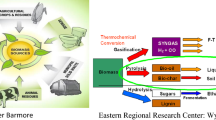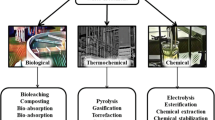Abstract
The allocation of resources between several blast furnaces in an integrated steelmaking plant is studied with the aim of finding the lowest specific operation cost for steel production. In order to reduce the use of fossil fuels, biomass was considered as an auxiliary reductant in the furnace after partial pyrolysis in an external unit, as a complement to heavy fuel oil. The optimization considers raw material, energy, and emission costs and a possible credit for sold power and heat. To decrease computational requirements and to guarantee that the global optimum is found, a piecewise linearized model of the blast furnace was used in combination with linear models of the sinter-, coke-, and power plants, hot stoves, and basic oxygen furnace. The optimization was carried out under different constraints on the availability of some raw materials as well as for different efficiencies of the hot stoves of the blast furnaces. The results indicate that a non-uniform distribution of the production between the furnaces can be advantageous, and some surprising findings concerning the optimal resource allocation under constrained operation are reported.





Similar content being viewed by others
Abbreviations
- c :
-
cost factor (€/t, €/km3n, or €/MWh)
- f :
-
function value after linearization
- F :
-
specific cost of liquid steel (€/tls)
- H :
-
effective heating value (MJ/kg)
- K :
-
coefficient in linear BF model
- m :
-
specific mass flow (kg/t)
- \({\dot{m}}\) :
-
mass flow rate (t/h)
- M :
-
large integer in MILP formulation (“big M”)
- p :
-
slope in x direction
- P :
-
electric power (MW)
- q :
-
slope in z direction
- \({\dot{Q}}\) :
-
heat flow (MW)
- T :
-
temperature (K)
- x :
-
variable in product
- X :
-
input variable in BF model
- \( y,{\tilde{y}}\) :
-
Binary variables in MILP formulation
- Y :
-
output variable in BF model
- z :
-
variable in product
- Z :
-
mass ratio
- ∆:
-
difference
- η :
-
pyrolysis yield
- Ψ:
-
share of fossil carbon in carbon input
- bio:
-
biomass
- coal:
-
coal
- coke:
-
coke
- dh:
-
district heat
- el:
-
electricity
- hm:
-
hot metal
- i :
-
general index
- j :
-
general index
- lime:
-
lime(stone)
- ls:
-
liquid steel
- O:
-
oxygen
- oil:
-
(heavy) fuel oils
- pel:
-
pellets
- pyro:
-
pyrolysis
- scrap:
-
steel scrap
References
Y. Kim and E. Worrell: Energy Policy, 2002, vol. 30, 827-38.
R.J. Fruehan: Ironmaking Steelmaking, 2005, vol. 32, pp. 3–8.
A. Ghosh and A. Chatterjee: Ironmaking and Steelmaking: Theory and Practice, Prentice-Hall, New Delhi, 2008.
M.A. Tseitlin, S.E. Lazutkin and G.M. Styopin: ISIJ Int., 1994, vol. 34, 570-73.
P.R. Austin, H. Nogami and J. Yagi: ISIJ Int., 1998, vol. 38, 239-45.
A. Hirsch, J. van der Stel, and D. Sert: Stahl Eisen, 2012, vol. 132 (4), p. 31.
H. Helle, M. Helle, H. Saxén and F. Pettersson: ISIJ Int., 2010, vol. 50, 931-38.
B.M. Hodge, F. Pettersson and N. Chakraborti: Steel Res., 2006, vol. 77, 459-61.
Y.S. Shen, B.Y. Guo, A.B. yu and P. Zulli: ISIJ Int., 2009, vol. 49, 819-26.
Y.S. Shen, A.B. Yu, P.R. Austin and P. Zulli: Powder Technology, 2012, vol. 223, 27-38.
J.A. de Castro, V.S. Guilherme, A.B. França, Y. Sazaki, and J.-I. Yagi: in Proceedings of the 6th International Congress on the Science and Technology of Ironmaking (ICSTI), Rio de Janeiro, Brazil, October 2012, pp. 338–47.
M.F. Henriques Jr., F. Dantas and R. Schaeffer: Energy Policy, 2010, vol. 38, 1946-61.
A. Babich, D. Senk and M. Fernandez: ISIJ Int., 2010, vol. 50, 81-88.
M. Takekawa, K. Wakimoto, M. Matsu-ura, M. Hasegawa, M. Iwase and A. McLean: Steel Res., 2003, vol. 74, 347-50.
W.-H. Chen, S.-W. Du, C.-H. Tsai and Z.-Y. Wang: Bioresour. Technol., 2012, vol. 111, 433-38.
S. Ueda, R. Inoue and T. Ariyama: Tetsu-to-Hagane, 2008, vol. 94,468-74.
H. Suopajärvi and T. Fabritius: ISIJ International, 2012, vol. 52,779-87.
H. Helle, M. Helle, F. Pettersson and H. Saxén: ISIJ Int., 2009, vol. 49, 1316-24.
H. Helle, M. Helle, F. Pettersson, and H. Saxén: Ironmaking Steelmaking, 2010, vol. 37, 590–98.
C.-M. Wiklund, F. Pettersson, and H. Saxén: ISIJ Int., 2012, vol. 52, 35–44.
J. Ranta, Production of charcoal: Handbook (in Finnish), Helsinki University, Finland, 1994.
H.E. Francis and W.G. Lloyd: J. Coal Qual., 1983, vol. 2, 21-25.
H. Aoki, H. Nogami, H. Tsuge, T. Miura and T. Furukawa: ISIJ Int., 1993, vol. 33, 646-54.
J.G. Mathieson, H. Rogers, M.A. Somerville and S. Jahanshahi: ISIJ Int., 2012, vol. 52, 1489-96.
A. Rist and N. Meysson: J. Met., 1967, vol. 19, 50-59.
H. Helle, M. Helle and H. Saxén: Chem. Eng. Sci., 2011, vol. 66, 6470-81.
IBM ILOG CPLEX V12.1 User’s Manual for CPLEX, 2009.
Acknowledgments
Financial support from the Association of Finnish Steel and Metal Producers and the Academy of Finland is gratefully acknowledged.
Author information
Authors and Affiliations
Corresponding author
Additional information
Manuscript submitted August 15, 2012.
Appendix
Appendix
The terms in the BF model (Eq. [1]) describing the effect of oxygen and energy in biomass[8] are non-linear with respect to the unknowns in optimizing F in Eq. [2], since η, Z O,bio, and H bio depend non-linearly on the unknown pyrolysis temperature (cf. Figure 2). This problem can be tackled by developing piecewise linearizations of the variables with a suitable discretization, as indicated schematically for the yield (η) in Figure A1. Next, the product terms in X 7 and X 8 must be linearized to allow for a MILP formulation. For the product of two variables, x and z, a discretization is first applied yielding a block structure (cf. Figure A2). For fixed discretization steps (Δx and Δz), the product at the center of a block is given by
where the lower index i is used to denote discretization points along the x variable and j similarly for the z variable. The slope in the x direction may be approximated as
which after simplification, gives
By analogy, the slope in the z direction is
The intercept of the linearized model now is given by
which simplifies to
Using these variables, the function of the product of x and z can now be expressed linearly as
In Eq. [A7], the variables k, v x , and v z are given by the conditions
where (“big”) M is a large number that serves to disconnect inactive values in detecting the block of interest for the product xz. The binary variables \( y_{i} ,\tilde{y}_{j} \in \left\{ {0,1} \right\} \), in turn, have to satisfy the conditions
and are connected to the values of x and z by
Rights and permissions
About this article
Cite this article
Wiklund, CM., Pettersson, F. & Saxén, H. Optimization of a Steel Plant with Multiple Blast Furnaces Under Biomass Injection. Metall Mater Trans B 44, 447–458 (2013). https://doi.org/10.1007/s11663-012-9790-8
Published:
Issue Date:
DOI: https://doi.org/10.1007/s11663-012-9790-8




